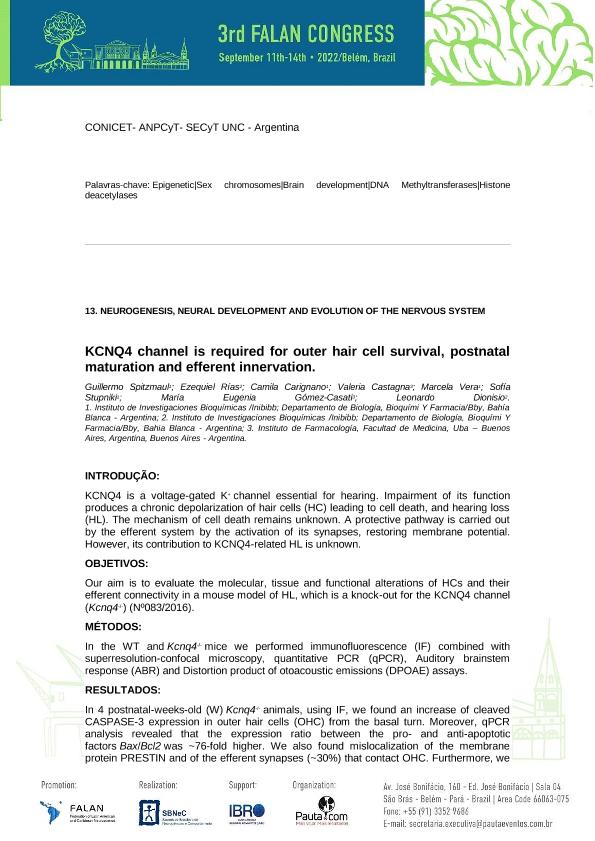Evento
KCNQ4 channel is required for outer hair cell survival, postnatal maturation and efferent innervation
Spitzmaul, Guillermo Federico ; Rias, Ezequiel Ignacio
; Rias, Ezequiel Ignacio ; Carignano, Camila
; Carignano, Camila ; Castagna, Valeria Carolina
; Castagna, Valeria Carolina ; Vera, Marcela Sonia
; Vera, Marcela Sonia ; Stupniki, Sofia
; Stupniki, Sofia ; Gomez Casati, Maria Eugenia
; Gomez Casati, Maria Eugenia ; Dionisio, Leonardo Raul
; Dionisio, Leonardo Raul
 ; Rias, Ezequiel Ignacio
; Rias, Ezequiel Ignacio ; Carignano, Camila
; Carignano, Camila ; Castagna, Valeria Carolina
; Castagna, Valeria Carolina ; Vera, Marcela Sonia
; Vera, Marcela Sonia ; Stupniki, Sofia
; Stupniki, Sofia ; Gomez Casati, Maria Eugenia
; Gomez Casati, Maria Eugenia ; Dionisio, Leonardo Raul
; Dionisio, Leonardo Raul
Tipo del evento:
Congreso
Nombre del evento:
3rd. Federación de Asociaciones Latinoamericanas y del Caribe de Neurociencias Congress
Fecha del evento:
11/09/2022
Institución Organizadora:
Federación de Asociaciones Latinoamericanas y del Caribe de Neurociencias;
Título del Libro:
3rd. Federación de Asociaciones Latinoamericanas y del Caribe de Neurociencias Congress
Editorial:
Federación de Asociaciones Latinoamericanas y del Caribe de Neurociencias
Idioma:
Inglés
Clasificación temática:
Resumen
INTRODUÇÃO: KCNQ4 is a voltage-gated K+ channel essential for hearing. Impairment of its function produces a chronic depolarization of hair cells (HC) leading to cell death, and hearing loss (HL). The mechanism of cell death remains unknown. A protective pathway is carried out by the efferent system by the activation of its synapses, restoring membrane potential. However, its contribution to KCNQ4-related HL is unknown. OBJETIVOS: Our aim is to evaluate the molecular, tissue and functional alterations of HCs and their efferent connectivity in a mouse model of HL, which is a knock-out for the KCNQ4 channel (Kcnq4-/- ) (Nº083/2016). MÉTODOS: In the WT and Kcnq4-/- mice we performed immunofluorescence (IF) combined with superresolution-confocal microscopy, quantitative PCR (qPCR), Auditory brainstem response (ABR) and Distortion product of otoacoustic emissions (DPOAE) assays. RESULTADOS: In 4 postnatal-weeks-old (W) Kcnq4-/- animals, using IF, we found an increase of cleaved CASPASE-3 expression in outer hair cells (OHC) from the basal turn. Moreover, qPCR analysis revealed that the expression ratio between the pro- and anti-apoptotic factors Bax/Bcl2 was ~76-fold higher. We also found mislocalization of the membrane protein PRESTIN and of the efferent synapses (~30%) that contact OHC. Furthermore, we found no changes in terminals volume but a 40% decrease in the number of synapses/OHC in Kcnq4-/- mice. By contrast, both genotypes at 2W exhibited the same immature wiring pattern. To test the hearing function, we performed ABR showing a significant threshold shift of 20-48 dB SPL in the 5.6-45.25 kHz frequency range. Besides, DPOAE test revealed a threshold shift of ~12-20 dB SPL in the 8-45.25 kHz range. CONCLUSÕES: We found new insights into the mechanism of HL in the Kcnq4-/- mice. While the basal OHCs die by apoptosis, hearing function is impaired in all cochlear regions
Palabras clave:
KCNQ4
,
Hearing
,
Deafness
,
Channel
,
Maturation
Archivos asociados
Licencia
Identificadores
Colecciones
Eventos(INIBIBB)
Eventos de INST.DE INVEST.BIOQUIMICAS BAHIA BLANCA (I)
Eventos de INST.DE INVEST.BIOQUIMICAS BAHIA BLANCA (I)
Citación
KCNQ4 channel is required for outer hair cell survival, postnatal maturation and efferent innervation; 3rd. Federación de Asociaciones Latinoamericanas y del Caribe de Neurociencias Congress; Belém; Brasil; 2022; 365-366
Compartir



